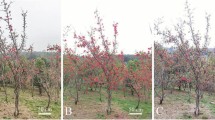Abstract
Pollen characteristics namely, pollen fertility (2% acetocarmine), viability (stain tests: Aniline blue, Lugol’s iodine, x-gal and Amido black), pollen production/flower (direct count using improved Neubauer Hemocytometer), pollen nuclei composition (following DAPI staining - 4′,6-diamidino-2-phenylindole) and pollen size along with parameters like capsule/plant, capsule length and seed set/capsule were studied in two cultivated (Corchorus capsularis L. and C. olitorius L.) and six wild (C. aestuans L., C. fascicularis Lamk., C. pseudocapsularis L., C. pseudoolitorius I. and Z., C. tridens L. and C. trilocularis L.) species of Corchorus under the Experimental field conditions of Kalyani University (West Bengal plains; latitude 22°50′–24°11′ N, longitude 88°09′–88°48′ E, elevation 48 ft above sea level, sandy loamy soil, organic carbon 0.76%, soil pH 6.85). Results obtained were statistically analyzed and the information accumulated may provide necessary impetus for formulating efficient breeding strategies and crop improvement. Further, clustering of the species on the basis of the attributes analyzed by UPGMA will be helpful for designing crossing experiments.


Similar content being viewed by others
References
Atiaksheva LF, Pilipenko OS, Poltorak OM. Mechanism of the thermoinactivation of the β-galactosidase from Escherichia coli. In: International Symposium, Biocatalysis-2000: undamentals & Applications, Lomonosov Moscow State University, Khimiya, Moscow, Russia. 2000;41(No.6. Supplement):95-97. www.chem.msu.su/eng/journals/vmgu/00add/95.pdf. Accessed 30 November 2011.
Bengtsson, S. Evaluation of transgenic Campanula carpatica plants. In: Epsilon Undergraduate Theses Archive: vol. 6. Dept. of Agricultural Sciences, The Royal Veterinary and Agricultural University. 2006. http://ex-epsilon.slu.se:8080/archive/00001970/. Accessed 28 March 2011.
Bhattacharya A, Datta AK. A report on genetic male sterility in Uraria picta (Jacq.) DC. Cytologia. 2011;76:55–62.
Bolat I, Pirlak L. An investigation on pollen viability, germination and tube growth in some stone fruits. Turk J Agric For. 1999;23:383–8.
Bots M, Mariani C. Pollen viability in the field. In: COGEM report, Radboud Universiteit Nijmegen, Netherlands. 2005. http://www.cogem.net/showdownload.cfm?objectId=FFFE6554-1517-64D9-CC081ED9E42EF28C&objectType=mark.apps.cogem.contentobjects. publication.download.pdf. Accessed 04 April 2011.
Davarynejad GH, Szabo Z, Nyeki J, Szabo T. Phenological stages, pollen production level, pollen viability and in vitro germination capability of some sour cherry cultivars. Asian J Plant Sci. 2008;7:672–6.
de Vries FT, van der Meijden R, Brandenburg WA. Botanical files: a study of the real chances for spontaneous gene flow from cultivated plants to the wild flora of the Netherlands. Gorteria Supplement. 1992;1:1–100.
Eijlander R, Stiekema WJ. Biological containment of potato (Solanum tuberosum): outcrossing to the related wild species black nightshade (Solanum nigrum) and bittersweet (Solanum dulcamara). Sex Plant Reprod. 1994;7:29–40.
Erdtman G. Pollen Morphology and Plant Taxonomy: Angiosperms (An Introduction to Palynology). The Chronica Botanica Co./Almqvist & Wiksell: 1952.
Ferri A, Giordani E, Padula G, Bellini E. Viability and in vitro germinability of pollen grains of olive cultivars and advanced selections obtained in Italy. Adv Hortic Sci. 2008;22:116–22.
Ghosh BK, Datta AK, Mandal A, Paul R. Cytological and palynological aspects and andrographolide content in Andrographis paniculata. J Trop Med Plants. 2011;12:71–6.
Groot MHM, van de Wiel CCM, van Tienderen PH, den Nijs HCM. Hybridisation and introgression between crops and wild relatives. In: Current knowledge and research priorities in lieu of impending introductions of GM crops: COGEM research report. University of Amsterdam & Plant Research International, Amsterdam & Wageningen. 2003. http://www.nwo.nl/files.nsf/pages/NWOA_6KNGVQ/$file/03%20COGEM%20-%20Uitrkuising%20-%20CGM2003-02.pdf. Accessed 05 April 2011.
Hard T, Fan P, Kearns DR. A fluorescence study of the binding of Hoechst 33258 and DAPI to halogenated DNAs. Photochem Photobiol. 1990;51:77–86.
Heslop-Harrison J, Heslop-Harrison Y, Shivanna KR. The evaluation of pollen quality, and a further appraisal of the fluorochromatic (FCR) test procedure. Theor Appl Genet. 1984;167:367–75.
Johnson S, McCormick S. Pollen germinates precociously in the anthers of raring-to-go, an Arabidopsis thaliana gametophytic mutant. Plant Physiol. 2001;126:685–95.
Karmakar PG, Hazra SK, Ramasubramanian T, Mandal RK, Sinha MK, Sen HS, editors. Jute and Allied Fibre Updates: Production, & Technology. CRIJAF, Brrackpore, India. 2008.
Keijzer CJ, Reinders MC, Leferink-ten Klooster HB. A micromanipulation method for artificial fertilization in Torenia. In: Cresti M, Jori P, Pacini E, editors. Sexual Reproduction in Higher Plants. New York: Springer; 1988. p. 119–24.
Kelly JK, Rasch A, Kalisz S. A method to estimate pollen viability from pollen size variation. Am J Bot. 2002;89:1021–3.
Kundu BC. Origin of Jute. Indian J Genet Plant Breed. 1951;2:95–9.
Lyra DH, Sampaio LS, Pereira DA, Silva AP, Amaral CLF. Pollen viability and germination in Jatropha ribifolia and Jatropha mollissima (Euphorbiaceae): Species with potential for biofuel production. Afr J Biotechnol. 2011;10:368–74.
Mahapatra AK, Saha A, Basak SL. Origin, taxonomy and distribution of Corchorus species in India. J Green. 1998;1:64–82.
Mahapatra AK, Saha A. Genetic resources of jute and allied fibre crops. In: Karmakar PG, Hazra SK, Ramasubramanian T, Sinha MK, Sen HS, editors. Jute and allied fibres updates: production and technology. Brrackpore: CRIJAF; 2008. p. 18–37.
Mather JP, Roberts, PE. Introduction to cell and tissue culture: Theory and Technique. 1st ed. Springer; 1998.
Marks GE. An aceto-carmine glycerol jelly for use in pollen-fertility counts. Biotechnic Histochem. 1954;29:277–8.
Purseglove JW. Tropical Crops: Dicotyledons 2. Longmans: Green; 1968.
Ramsay G, Thompson C, Squire G. Quantifying landscape-scale gene flow in oilseed rape. In: Final Report of DEFRA Project RG0216: An experimental and mathematical study of the local and regional scale movement of an oilseed rape transgene. Scottish Crop Research Institute, Dundee: DEFRA. 2003. http://www.scri.ac.uk/scri/file/EPI/Agroecology/Landscape_scale_geneflow_in_oilseed_rape_rg0216.pdf. Accessed 30 June 2011.
Regan SM, Moffatt BA. Cytochemical analysis of pollen development in wild-type Arabidopsis and a male-sterile mutant. Plant Cell. 1990;2:877–89.
Sedgley M, Griffin AR. Sexual Reproduction of Tree Crops. Academic Press: 1989.
Sharma MLP, Singh ML. Floral behaviour in Saccharum officinarum hybrids and S. spontaneum clones. Indian J Agr Sci. 1996;66:455–8.
Stanley RG, Linskens HF. Pollen: biology, biochemistry, management. 1st ed. Springer; 1975.
Willemse MTM, Keijzer CJ. Tracing pollen nuclei in the ovary and ovule of Gasteria verrucosa (Mill.) H. Duval after pollination with DAPI-stained pollen. Sex Plant Reprod. 1990;3:219–24.
Acknowledgement
The Research is grant aided by University Grants Commission (India).
Author information
Authors and Affiliations
Corresponding author
Rights and permissions
About this article
Cite this article
Mandal, A., Datta, A.K. & Bhattacharya, A. Evaluation of pollen and productive parameters, their interrelationship and clustering of eight Corchorus spp. (Tiliaceae). Nucleus 54, 147–152 (2011). https://doi.org/10.1007/s13237-011-0044-y
Received:
Published:
Issue Date:
DOI: https://doi.org/10.1007/s13237-011-0044-y




